 |
| The mechanical lock industry is experiencing an increased penetration of Chinese suppliers into the international market |
Despite the growing popularity of access control systems driving the adoption of electronic locking devices, mechanical locks are not projected to falter any time soon. Mechanical locks are forecast to have a positive compound annual growth rate (CAGR) of 3.8% from 2013 to 2017, a new report from IHS.
While access control is driving the penetration of electronic locking devices such as electromagnetic locks, electric strikes, and electronic locks, most applications still require a mechanical lock override in the case of a power failure or system error. Consequently, the trend towards more access control systems only limits the growth of mechanical locks in the medium-term; it does not necessarily replace them.
Additionally, for many end-users, the cost of an online electronic access control solution remains cost prohibitive, so these end-users must continue to rely on mechanical solutions. Although electronic access control solutions remain expensive, more end-users are seeing the value of being able to control access rights securely and efficiently, monitor door status in real time, create audit trails and the ability to lockdown all doors immediately in the case of an emergency. As a result, electronic access control solutions are still forecast to have stronger growth rates than mechanical globally from 2013 to 2017 both in terms of revenues and units.
The mechanical lock industry itself is experiencing an increased penetration of Chinese suppliers into the international markets. These lower cost suppliers are increasing their market share in EMEA and the Americas which is influencing the average sales price (ASP) of mechanical locks downward regardless of rising material costs. Chinese suppliers are more prevalent in price sensitive regions such as Eastern Europe and Latin America, but are increasing their partnerships with “sister” companies in the US and Western Europe. The ASP for mechanical locks globally is anticipated to decline 0.6% from 2013 to 2017 as a result.
Overall, the mechanical locks market is slated for positive growth in the medium-term, with strong construction activity in emerging markets and the BRIC countries continuing to drive demand for mechanical locking solutions. However, more mature market such as the US and Europe, will see more of an impact by electronic access control systems, but cannibalisation should be minimal in the medium term.


















